
The Osaka Aquarium Kaiyukan is an aquarium located in the ward of Minato in Osaka, Japan, near Osaka Bay. It is one of the largest public aquariums in the world, and is a member of the Japanese Association of Zoos and Aquariums (JAZA).

The New Zealand demoiselle, Chromis dispilus, is a damselfish of the genus Chromis, found between North Cape and East Cape of the North Island of New Zealand to depths of about 60 metres, off rocky coasts. Its length is between 15 and 20 cm. Males are highly territorial as they defend their nesting area from other males and other species. These aggressive fish defend their eggs laid by their female counterpart. Spawning occurs between the months of December and March. The New Zealand demoiselle's territory and nesting grounds of this fish are usually the largest in a medium population density. Like most territorial fish they tend to spawn more in higher densities of the same species compared to lower densities. Aggression levels tend to be higher amount higher densities of the same species and lower levels in smaller densities. Aggression also tends to be higher during spawning then during egg defending. Elevated plasma levels of androgen testosterone and 11-Ketotesterone are associated with the heighten levels of aggression shown by the males.
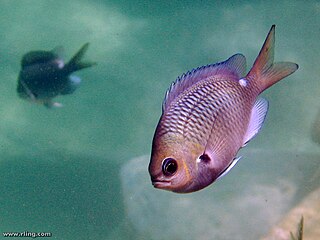
The one-spot puller or brown puller, Chromis hypsilepis, is a damselfish of the genus Chromis, found off south-east Australia and between North Cape and East Cape of the North Island of New Zealand to depths of about 60 metres, off rocky coasts. It grows to a length between 15 and 20 centimetres.

Chromis is a genus of fish in the family Pomacentridae. While the term damselfish describes a group of marine fish including more than one genus, most damselfish are in the genus Chromis. These fish are popular aquarium pets due to their small size, tolerance for poor water quality, and bright colors.
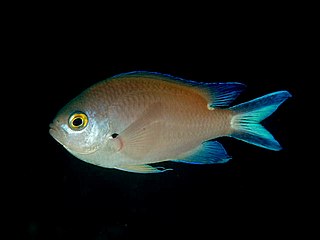
The smokey chromis, also known as the smokey puller or the yellow demoiselle, is a damselfish of the genus Chromis, found in the tropical waters of the eastern Indian Ocean, and the western Pacific Ocean across to north New Zealand, at depths of between 3 and 25 metres, off rocky or coral reef areas. Its length is between 5 and 10 cm.

Chromis viridis is a species of damselfish. Individuals tend to be iridescent apple-green and light blue, and reach a maximal length of 10 cm.
Chromis abyssus is a species of damselfish first discovered in 1997 and described in 2008. The 8 centimetres (3.1 in) long fish only lives more than 110 m (361 ft) below the surface of the Pacific Ocean around the coast of the Ngemelis Islands, Palau. Adults have been observed living singly or in pairs, whereas juveniles tend to live in groups.

Chromis cyanea is a damselfish in the subfamily Pomacentrinae, found in Bermuda, southern Florida and the Caribbean Sea.

Chromis iomelas, also known as the Half and Half Chromis, is a species of reef dwelling fish in the family Pomacentridae. It is occasionally seen for sale in the aquarium trade.

Chromis chromis, the damselfish or Mediterranean chromis is a small species of ray-finned fish of the family Pomacentridae from the Eastern Atlantic and Mediterranean.
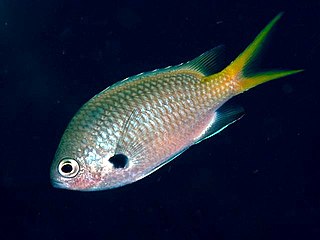
Chromis flavomaculata, commonly known as the Yellowspotted chromis, is a Chromis from the Western Pacific. It occasionally makes its way into the aquarium trade. It grows to a size of 16 cm (6.3 in) in length.
Chromis brevirostris, the shortsnout chromis, is a species of Chromis first described in 2008 from the Pacific Ocean around Palau. They have also been sighted in the Marshall Islands close to Fiji, in the Caroline Islands from Puluwat to Palau, and south of Vanuatu. It is generally abundant in its environment, living at depths of 90–120 metres (300–390 ft), tending to live in groups ranging in size from six to several dozen.

ZooBank is an open access website intended to be the official International Commission on Zoological Nomenclature (ICZN) registry of zoological nomenclature. Any nomenclatural acts need to be registered with ZooBank to be "officially" recognized by the ICZN Code of Nomenclature.
Garra notata, the Tenasserim garra, is a species of ray-finned fish in the genus Garra. This species is also known as Tenasserim garra, after the Tenasserim Hills.

Chromis margaritifer, known commonly as the bicolor chromis, is a species of marine fish in the family Pomacentridae.
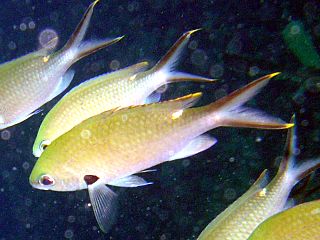
Chromis multilineata is a species of fish in the family Pomacentridae. It is commonly known as the brown chromis. It is found in the western Atlantic Ocean from the southern United States south to Brazil and in the eastern Atlantic off St Helena and Ascension Island

The Barrier Reef chromis, also known as the yellowback puller or shining puller, is a species of damselfish in the family Pomacentridae native to the east coast of Australia. It is a small fish with a yellowish-brown dorsal surface separated by a dark stripe from its silvery flanks and underside.
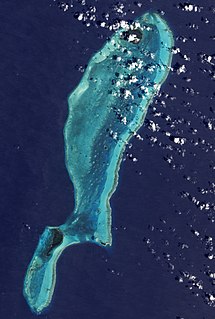
Lighthouse Reef is an atoll in the Caribbean Sea, the easternmost part of the Belize Barrier Reef and one of its three atolls, the other two being Turneffe Atoll and Glover's Reef. Lighthouse Reef is located about 80 kilometres (50 mi) southeast of Belize City. The atoll is of oblong shape, approximately 35 kilometres (22 mi) long from north to south, and about 8 kilometres (5.0 mi) wide. It forms a shallow sandy lagoon with an area of 120 square kilometres (46 sq mi) and a depth between 2 to 6 metres deep.
Chromis degruyi is a species of fish in the family Pomacentridae. It was first found at depths greater than 60 metres (200 ft) in a coral reef habitat in the western Pacific, specifically the Caroline Islands. It differs from its cogenerates on a colour and morphological basis.
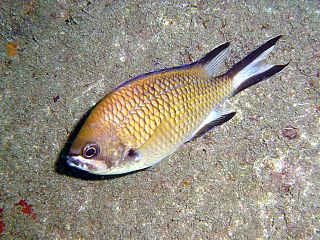
The Azores chromis or Atlantic chromis is a species of damselfish from the family Pomacentridae which is found in the Macaronesian Islands of the temperate eastern Atlantic Ocean and has been reported from coastal regions of western Africa.

















